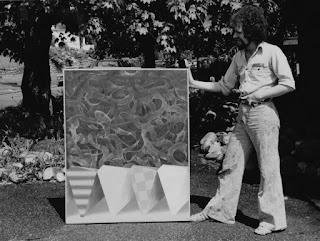With the New Dimension Jazz Trio, 1964-'65
ENSEMBLES
1964: New Dimension
Jazz Trio
- Don French, marimba/ Andreas Naumann or Richard Anstey, bass/
Gregg Simpson, drums
1965-70:
Al Neil Trio - Al Neil,
piano, voice, toy instruments, zither/ Richard Anstey, bass,soprano
sax,
toy instruments, voice/ Gregg Simpson, drums, percussion, toy
instruments,
sound collages.
Double CD: Retrospective
1965-1968, released in 2002
1970-71:
Vitaphone Houseband -
Alan Sharpe, guitar/ Tom Hazlitt, bass/ Gregg Simpson, drums
New Atlantis Houseband
- Alan Sharpe, guitar/ Richard Anstey, soprano sax, Gregg Simpson, drums
1972:
Al Neil Jazz Probe
(Quartet) - Al Neil, piano/ Richard Anstey, soprano sax/ Annie
Seigel,
alto
sax,flute/ Gregg Simpson, drums. Al Neil Jazz Probe Orchestra -
Al Neil, piano/ Richard Anstey, soprano sax/ Annie Seigel, alto
sax, flute/ Nelson Lepine, electric guitar/ Phil Morgan, Fender bass/ Gregg Simpson, drums
1973:
Bruce Freedman Trio -
Bruce Freedman, tenor,alto sax/ Lincoln Goines, bass/ Gregg Simpson,
drums
Apex - Bill Runge, sax,
bass/ Gordon Waters, trombone/ Richard Murphy, guitar/ Lincoln Goines,
bass/ Gregg Simpson, drums
1974-75:
Sunship Ensemble - Ross
Barrett, tenor sax, flute, keyboards/ Richard Anstey,
soprano
sax/ Bruce Freedman, tenor sax, Alan Sharpe, guitar/ Clyde Reed, bass/
Gregg Simpson, drums.

Sunship Ensemble opening for Keith Jarrett
at the Commodore Ballroom, Vancouver, 1974.
1976:
Vancouver Sound Ensemble -
Bruce Freedman, tenor sax/ Paul Plimley, piano/ John Giordano, bass/
Gregg
Simpson, drums
Vancouver Sound Ensemble, Burnaby Art Gallery, 1976
(Bruce Freedman, tenor saxophone; Gregg Simpson, drums)
1977:
Rio Bumba - Bruce
Freedman,
tenor sax/ Gerry Silver, guitar/ Albert St. Albert, conga/ Lisle Ellis,
bass/Gregg Simpson, drums.
1977-80
New Orchestra Quintet -
Paul Cram, alto, tenor sax/ Ralph Eppel, trombone/ Paul Plimley,
piano/ Lisle Ellis, bass/ Gregg Simpson,
drums
1978:
C.O.R.D. Orchestra -
Various
members of the New Orchestra Workshop
1979:
Sessione Milano - Don
Druick, flute/ Paul Cram, alto, tenor sax/ Jane Phillips, cello/ Paul
Plimley,
piano/ Lisle Ellis, bass/ Gregg Simpson, percussion
1980:
A-
Group - Paul Cram, alto, tenor
sax, flute/ Ralph Eppel, trombone, trumpet/ Bob Bell. guitar, alto sax/
Gregg Simpson, drums
1981:
Paul
Cram Quartet - Paul
Cram, tenor sax/ Paul Plimey, piano, vibraphone/ Lisle Ellis, bass/
Gregg Simpson, drums
E.S.B.
- Ralph Eppel, trombone,
trumpet, electric bass/ Bob Bell, guitar, electric bass, alto sax/
Gregg Simpson, drums, percussion
1982 -
83:
Paul
Cram Trio - Paul Cram, alto,
tenor sax/ Lisle Ellis - electric bass/ Gregg Simpson, drums
1983-84:
Motion
- Coat Cooke, tenor sax/
Paul Plimley, piano/ Clyde Reed, bass/ Gregg Simpson, drums
1985-92:
Lunar
Adventures - Coat Cooke,
tenor, alto sax/ Ron Samworth, guitar/ Clyde Reed, bass/ Gregg Simpson, drums
1985-87:
Vancouver
Art Trio - Bruce
Freedman,
tenor sax/ Clyde Reed, bass/ Gregg Simpson, drums
The Vancouver Art Trio
Centre Culturel Colombien, Vancouver, 1986
1986 - 1989
Paul
Plimley Trio - Paul Plmley,
piano/ Clyde Reed, bass/ Gregg Simpson, drums
1992-1995
Henry
Boudin Trio - Henry Boudin,
tenor sax/ Clyde Reed, bass/ Gregg Simpson, drums
1993-1994
Tribal
Dynamics - Francois
Houle,soprano
sax, clarinet/ Bruce Freedman, soprano sax, Dan Kane, tenor sax/ Ralph Eppel, tombone,
trumpet,
percussion/ Brad Muirhead, sousaphone, trombone/ Clyde Reed, bass/ Gregg Simpson, drums,
percussion
Tribal Dynamics in Concert
du Maurier Jazz Festival, Granville Island, 1994
Tribal Dynamics
Pitt International Gallery,1993
1992-99:
Ralph
Eppel Quintet - Ralph
Eppel,
trombone, trumpet/ Olrecht Zeitek - tenor sax/ Tony Wilson, guitar/
Danny Parker, bass (also
James
Young or Paul Blaney, bass) Gregg
Simpson,
drums
2002:
Module - Coat
Cooke-tenor/alto
saxophone / Clyde Reed-bass/ Gregg
Simpson-drums
2006:
Coat Cooke-tenor/alto
saxophone / Paul Blaney-bass/ Gregg
Simpson-drums
2008/2009:
Collage, Homage
to Al Neil / Sound Gallery - Vivien
Houle, vocalist / Paul Plimley-piano, Stefan Smulovits, electronics and
viola, Clyde Reed, bass/ Gregg Simpson, drums / Krista Lomax, visuals.
20011/2012:
Sound Image Net - Carole Sawyer,
vocalist / Jarrod Burrows - guitar / Clyde Reed, bass / Gregg Simpson,
drums / Krista
Lomax, visuals.
2015:
Sound Image Net - Carole Sawyer,
vocalist / Jarrod Burrows - guitar / Paul Cram - reeds / Ralph Eppel -
trombone / Clyde Reed, bass / Gregg Simpson,
drums
Compositions
1993:
Runningboard Rag, The Herky Jerk
1992: La Pasionara
1989:
Jou Jouka Jig, Reelin' In
1988:
Stone's Throw, Song of the Soil
1987:
Cairn
1986:
Mirage Dance
1985:
Solomon, Harmolodic
Highlanders,
Celtic
Calypso
1984:
Canyon Suite, Basement Blues, The Fever, Green Mansions
1983:
Paganology, Night Rider, Oscillation
1982:
Forest City Blues, Duende, Loopfinder, Symbolist Waltz #2;
Strange Air, Blue Orient
1981:
Seein' it Through
1979:
Budapest Steppe, Slow Curve
1978:
Public Nuance, Symbolist Waltz #1, Projections,
Samba del Oro
1977:
Blues on Pluto
|































